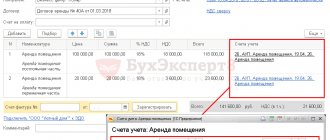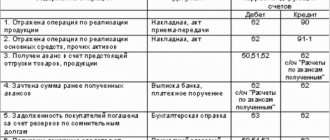Accounting for import transactions
In accordance with the Federal Law of December 8, 2003 No. 164-FZ “On the Fundamentals of State Regulation of Foreign Trade Activities” (as amended and supplemented) (clause 10 of Article 2), import of goods is the import of goods into the Russian Federation without the obligation to re-export .
To avoid problems with legislation, it is necessary to very scrupulously maintain both accounting and tax records of import transactions.
Accounting for import transactions is in many ways similar to tax accounting, but there are a number of distinctive features:
| Similarities | Differences |
| When determining the cost of goods, the costs incurred by the taxpayer when importing goods into the territory of the Russian Federation are taken into account. Actual costs can be classified as expenses when calculating the organization's income tax. | When calculating income tax, an organization has the right to write off expenses in any manner convenient for it. |
To which accounts should payments for import transactions be attributed?
The declaration of goods transported to the territory of the state must be carried out within the strictly established time frames established by the Legislation of the Russian Federation. They are 15 days after the day of delivery of products and necessary means of transport.
The following types of payments are charged upon import:
- customs duty;
- excise taxes;
- fees required to cover customs clearance costs;
- value added tax (as opposed to export transactions).
The payer must pay all these payments on time. The deadline for paying customs duties is before drawing up the declaration or simultaneously with its submission. But standard deadlines must be observed - no later than 15 calendar days after the products arrive at the territory of the customs authority.
The import payment account may vary depending on the type of product transported:
- If materials are transported, then the entry for the advance payment for customs is D15 K76.
- If goods are transported, then the wiring is D41 K76.
All customs payments payable by foreign trade participants are expressed in the same currency as the customs value of the imported products.
In order for cargo transportation across the border to go smoothly, it is necessary to calculate customs duties and fees correctly. Foreign trade participants should learn how to calculate payments independently. Information about the types of payments in the customs declaration is in this article. These are mandatory payments for export/import operations.
VAT on import
When accounting for import transactions, special attention should be paid to such payment as value added tax. The main difference between import transactions and export transactions is the taxpayer’s obligation to pay VAT.
The formula for calculating this payment includes the following components:
- excise taxes;
- customs value of transported products;
- customs duty.
All these indicators are added together to obtain value added tax.
Posting for VAT calculation - D19/3 K68/1. In subsequent operations and procedures, the reverse of this wiring is used - D68/1 K 19/3.
In addition, watch the video tutorial “Capitalization of imported goods” in the 1C program:
So, the payment of customs duties is regulated by the Customs Code of the Customs Union. And VAT and excise taxes refer to tax payments. That is why they must be strictly separated in accounting. It allows you to monitor the implementation of payments and compliance with all repayment deadlines established by the Legislation of the Russian Federation.
You can find more information on the topic in the Customs payments section.
Free consultation by phone:
+7 (call is free)
Attention! Due to recent changes in legislation, the legal information in this article may be out of date!
Our specialist will advise you free of charge.
An organization that purchases goods (services) abroad of the Russian Federation must pay VAT when importing the purchased goods (services) at customs. Let's look at how to calculate, charge and receive a deduction for VAT paid at customs when importing, how to reflect import VAT in the purchase book and declaration, as well as transactions generated for VAT when importing goods and services.
Accounting entries for accounting for import transactions
A detailed explanation of accounting and tax accounting for import transactions will be given below:
| Accounting entry | Explanation | Document confirming the operation | |
| D 60 | K 52 | Transfer of advance payment to the supplier for imported goods | Bank statement, payment order |
| D 76 | K 51 | Payment of customs duties | DT, bank statement, payment order |
| D 07 D 08-4 D 10 D 41 | K 60 K 76 | Ownership rights to goods as:
The owner makes an independent decision, guided by regulations. | Form No. OS-14 “Act of acceptance (receipt) of equipment” Form No. MX-1 “Act of acceptance and transfer of inventory items for storage” Form TORG-1 “Act of acceptance of goods” |
| D 19 | K 76 | Import VAT reflected | DT, bank statement, accounting certificate |
| D 07 D 08-4 D 10 | K 60 | Costs of delivering property to the territory of the Russian Federation | Accounting information |
| D 19 | K 60 | VAT on property transportation | Invoices, accounting certificates |
| D 01 | K 08-4 | Capitalization of received property | Form No. OS-1 “Act of acceptance and transfer of fixed assets (except for buildings, structures)” |
| D 68 | K 19 | Submitting import VAT for deduction | Invoice, accounting certificate |
| D 60 | K 91-1 | Accrual of positive exchange rate differences on settlements with suppliers in foreign currency | Accounting information |
| D 91-2 | K 60 | Accrual of negative exchange rate differences on settlements with suppliers in foreign currency | Accounting information |
| D 60 | K 52 | Final payment to the supplier for the imported goods | Bank statement |
State duty for customs accounting entries 2021 in 1s 8
To what account should the state duty be attributed? Usually, subaccount 68.10 is used for this - Other taxes and fees. The postings will be as follows:
- Debit 08 (10.41...) Credit 68.10 - state duty for the acquisition of rights or property.
- Debit 20 (26.44...) Credit 68.10 - state duty on transactions related to the main activities of the company.
- Debit 91-2 Credit 68.10 - state duty on transactions unrelated to the main activities of the company.
- Debit 68.10 Credit 51 - transfer of state duty.
The state fee for notary services can be paid by the accountable person. Then the wiring will look like this:
- Debit 68.10 Credit 71 – state duty paid by the accountable person.
In tax accounting, this type of business transaction is taken into account as other expenses of the organization. The moment of recognition is the date of accrual.
State duties in 1s 8.3: examples, postings, reflection
Customs authorities must release the goods no later than three working days from the date of acceptance of the customs declaration, as well as from the day of presentation of the goods to the customs authorities (Article 152 of the Labor Code of the Russian Federation), therefore goods can be released, and additional customs payments accrued later. Cost adjustment is carried out using special forms (CTS). If, as a result of the adjustment, the amount of customs duties has increased, an additional payment must be made.
Payment of additionally calculated amounts of customs duties and taxes must be made within 10 working days from the date of receipt of the customs officers’ request. In this case, penalties are not charged on the additional amount of customs duties and taxes paid within the specified period. Customs checks the correctness of filling out the specified forms and the receipt of the additional amount of customs duties and makes a decision on the release of the goods.
State duties in 1s 8.3: postings and reflection in examples
These include:
- costs of transporting goods to the place of their import into Russia (airport, port or border checkpoint);
- cost of packaging, including the cost of packaging materials and packaging work;
- the cost of goods (work, services) that you transferred free of charge or at a reduced price to a foreign supplier for the production of imported goods;
- licensing and other fees for the use of intellectual property that you must pay as a condition of the sale of imported goods;
- part of your income from the resale or use of imported goods, which you are contractually obligated to transfer to the supplier.
You cannot use this method if the contract does not specify the value of the imported goods or you and your foreign supplier are related parties.
Customs payments when importing goods
Debit 99-2 Credit 68 - 21,995 rub. (RUB 91,646.85 x 24%) - reflects the conditional income tax expense. Taxable profit from the sale of goods for the reporting period will be 44,803.59 rubles. (720,000 - 120,000 - 461,509.88 - 93,686.53). Debit 68 Credit 77 - 11,242 rubles. ((93,686.53 - 46,843.27) x 24%) - reflects the deferred tax liability. Income tax payable to the budget will be 10,753 rubles. (21,995-11,242).
As taxable temporary differences are reduced or completely settled (in this case, in subsequent periods when the remaining imported goods are sold), deferred tax liabilities will be reduced or completely settled. Amounts by which deferred tax liabilities are reduced or fully repaid in the reporting period are reflected in accounting by posting to the debit of account 77 and the credit of account 68.
We optimize the accounting of customs payments...
Reflection of customs payments in accounting and tax accounting
Let us remind you that from January 1, 2005 the situation will change, since in accordance with the changes (read more here) introduced by Federal Law No. 95-FZ of July 29, 2004, the system of taxes and fees of the Russian Federation will not include mandatory deductions (in particular, customs duties), the collection of which is regulated by independent branches of legislation. The Tax Code of the Russian Federation regulates (in terms of VAT and excise taxes):
- the import of which goods is not subject to taxation (Article 150, paragraph 3 of Article 183 of the Tax Code of the Russian Federation);
- features of taxation when importing goods (clause 1 of Article 151, Article 152, clause 1 of Article 185, clause 1 of Article 186 of the Tax Code of the Russian Federation);
- the procedure for determining the tax base for the import of goods (clause 1 of Article 153, Articles 160, 191 of the Tax Code of the Russian Federation);
- tax rates (clause 5 of article 164, article 193 of the Tax Code of the Russian Federation);
- procedure for calculating tax when importing goods (clause 5, article 166, art.
Accounting entries for state duties - accrual and payment
Secondly, create the cost of materials using accounting prices. Let's look at both options in more detail. Option one.
Reflection of payment of state duty in 1s 8.3
If the payment was transferred in rubles, there is no need to enter the exchange rate (in this case, the entry consists of three groups of numbers). For example, 12-6571.11-810 will mean that a ruble fee for customs clearance (code 12) in the amount of 6571.11 rubles has been paid (currency code rubles, in accordance with the All-Russian Classifier of Currencies - 810).
Tax accounting of import transactions
According to paragraph 3 of paragraph 1 of Article 268 of the Tax Code of the Russian Federation, when selling property or property rights, the taxpayer has the right to reduce income from such transactions by the amount of expenses directly related to such sale.
The following expenses are accepted for accounting: (click to expand)
- at the rate;
- storage;
- service;
- transportation.
In accordance with Article 320 of the Tax Code of the Russian Federation, the procedure for determining expenses for trade operations is determined. According to this normative act, the amount of distribution costs includes expenses for:
- delivery of goods;
- warehousing costs;
- other expenses associated with the purchase of goods.
The taxpayer has the right to determine the cost of goods taking into account distribution costs. The formation of the cost of goods is explained in detail in the section “How is the cost of imported goods formed?”.
Example of accounting for import transactions
ABC LLC purchased goods in Spain for the amount of €8,000 on July 11, 2017. ABC LLC received property rights to the goods on July 11, 2017.
- Customs duty – 12,000 rubles.
- Customs duty – 15%.
- Calculated VAT: 8000*68.77*1.15*0.18=113883.12 rubles.
- Costs for delivery of property to the territory of the Russian Federation 34650.00 (including VAT 6237.00)
On July 16, 2017, the final payment for the goods was made. € exchange rate: 07/11/2017 – 68.77 rubles, 07/16/2017 – 68.36 rubles.
| Accounting entry | Explanation | Amount (rub.) | |
| D 76 | K 51 | Payment of customs duties | 12 000,00 |
| D 76 | K 51 | Payment of customs duties | 82 524,00 (8000*68,77*0,15) |
| D 07 D 08-4 D 10 D 41 | K 60 K 76 | Ownership rights to goods as:
The owner makes an independent decision, guided by regulations. | 550 160,00 (8000*68,77) |
| D 19 | K 76 | Import VAT reflected | 113 883,12 |
| D 07 D 08-4 D 10 | K 60 | Costs of delivering property to the territory of the Russian Federation | 34 650,00 |
| D 19 | K 60 | VAT on property transportation | 6 237,00 |
| D 01 | K 08-4 | Capitalization of received property | 550 160,00 |
| D 68 | K 19 | Submission for VAT deduction | 120 120,12 (113 883,12+6237) |
| D 60 | K 91-1 | Accrual of positive exchange rate differences on settlements with suppliers in foreign currency | 3 280,00 (8000*(68,77-68,36)) |
| D 60 | K 52 | Final payment to the supplier for the imported goods | 546 880,00 (8 000*68,36) |
How to take into account VAT when importing in accounting using an example
Let's take a closer look at an example of how to reflect VAT on imports in accounting entries:
Let’s say that VESNA LLC, on December 12, 2016, purchased goods from a foreign company for a total amount of $5,000. According to the terms of the contract, ownership passes upon receipt of the goods, that is, on December 12, 2016. Customs duty - 15%. Customs duty - 7,500 rubles. Services for customs clearance amount to 70,800 rubles, incl. VAT 18% - 10,800 rub.
US dollar rates:
- as of December 12, 2016 equals 63.3028;
- as of December 19, 2016 equals 61.7515.
The accountant of Vesna LLC reflected VAT on imports with the following entries:
| Debit Account | Credit Account | Transaction amount, rub. | Wiring Description | A document base |
| 41 | 60 | 361 514,00 | Purchased imported goods were capitalized (5,000 * 63.3028) | Certificate of acceptance of goods TORG-1 |
| 41 | 76 | 7 500,00 | The amount of customs duty on imported goods is reflected | Accounting information |
| 41 | 76 | 47 439,00 | The amount of customs duty on imported goods is reflected ((5,000 * 61.7515+ 7,500)*15%) | Accounting information |
| 19 | 76 | 64 115,37 | The amount of calculated customs VAT is reflected ((308,757.50 + 47,439.00) *18%) | Invoice received, Accounting certificate |
| 41 | 60 | 60 000,00 | The cost of the service for customs clearance of purchased imported goods is reflected. | Accounting information |
| 19 | 60 | 10 800,00 | The amount of VAT on services is reflected (60,000.00 * 18%) | Invoice received |
| 60 | 52 | 308 757,50 | Payment for purchased imported goods has been transferred (5,000.00 * 61.7515) | Bank statement |
| 60 | 91 | 7 101,50 | The exchange rate difference is reflected (5,000.00 *(61.7515-63.1718)) | Accounting information |
| 68 | 19 | 74 915,37 | Paid VAT is accepted for deduction (64,115.37 + 10,800.00) | Invoice received, Accounting certificate |
Errors in accounting for import transactions
When accounting for import transactions, you must be very careful to avoid errors that are often identified during an audit:
- incorrect conversion of foreign currency into rubles when conducting a foreign exchange transaction;
- there is no translation into Russian of the text of the document on the basis of which payment is made from a foreign currency account;
- failure to meet deadlines for fulfilling obligations under contracts that provide for advance payments;
- incorrect correspondence of invoices for accounting of import transactions.
Documents required for registration of imported goods
According to the Federal Law of December 6, 2011 No. 402-FZ “On Accounting” (Article 9), each fact of economic activity must be subject to registration with a primary accounting document. To account for import transactions, the primary accounting documents, the presence of which is necessary for accounting and tax accounting of imported goods, are:
- foreign trade contract with the importer of goods;
- invoice issued by the seller;
- transport, forwarding documents;
- insurance documents;
- declaration of goods (DT);
- bank certificates confirming payment of customs duties and taxes;
- invoices, acts of acceptance of inventory items;
- technical documentation.
Category “Questions and Answers”
Question No. 1. Are we required to make advance payments to a foreign seller when purchasing imported goods?
The obligation to pay an advance payment arises provided that this obligation appears in the contract that you have concluded with the foreign supplier. If the contract does not provide for an advance payment when purchasing imported goods, you are not obliged to pay it.
Question No. 2. Do I understand correctly that accounting for goods begins on the day the property rights to them are transferred, even if the goods have not yet been received and paid for?
Yes, in accordance with the legislation of the Russian Federation, the buyer of imported goods accepts the goods for fixed assets or inventories at the time of transfer of property rights from the seller.







